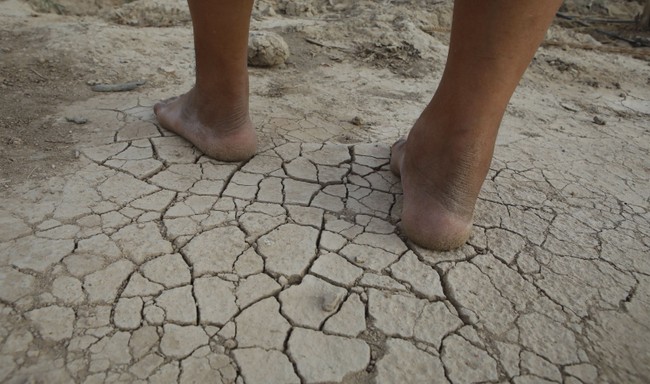
This has been running under most news radars, but it’s literally a catastrophe for the mullahs.
After decades of mismanagement, illicit drilling, and indulging the citizens of the capital at the expense of the poorer rural areas, Iran is rapidly depleting what few water resources it has left.
Iran’s critical water shortage, exacerbated by decades of mismanagement and drought, threatens to make Tehran uninhabitable https://t.co/4fefXde4Gr pic.twitter.com/C3qwdgo3uh
— Reuters (@Reuters) November 12, 2025
Exacerbated by six continuous years of drought, the situation is so dire that the Iranian president, Masoud Pezeshkian, has said the capital city of Tehran might have to be ‘evacuated’ before winter.
Even if such an extreme move does not prove to be immediately necessary, Pezeshkian has said, Tehran cannot continue in its current place and form. The area will not sustain any further human occupation or development.
Iranian President Masoud Pezeshkian said Thursday that the country’s capital should be relocated away from Tehran because of overcrowding and a deepening water crisis.
Pezeshkian has raised the idea of moving away from Tehran before, with rainfall in the capital this year at its lowest level for a century.
“The reality is that we have no choice. It (the relocation) is a necessity. We cannot overwhelm this region with more population and construction,” he said, according to the official IRNA news agency.
“We can develop, but we cannot solve its water problem.”
The Iranian president warned earlier this month the current capital could be evacuated without rainfall before winter, though he did not elaborate.
Tehran nestles on the southern slopes of the Alborz mountains and has hot dry summers usually relieved by autumn rains and winter snowfall.
The mountain peaks, usually already covered in snow at this time of year, are still dry.
The Iranian government has resorted to water cuts across the capital in an attempt to stretch out what flow they are receiving through hastily cut channels and aqueducts from terribly depleted, ill-conceived, and poorly maintained reservoirs. This is coming as a shock to residents of the city, who were not aware of the gravity of the situation, thanks to the regime’s focus on maintaining a faux sense of normality.
The last thing the mullahs needed to upset their already tenuous hold on the country was a catastrophic infrastructure breakdown in the face of rising unrest, and now they’ve engineered a whopper of one all by themselves.
In recent days, prolonged water cuts across Tehran have created widespread panic among the Iranian capital’s 10 million residents. Last week, after years of drought and reduced rainfall and snowfall, Iranian President Masoud Pezeshkian warned that Tehran’s residents would have to ration water—and eventually evacuate the capital—if there was no rain by late November. They’ve had years of warning, but Iran’s rulers have done nothing to resolve an increasingly existential water crisis.
A few experts have been warning about the impending doom for decades. Most Tehranis, insulated from the hardships long faced by poorer, peripheral provinces, are only now feeling what other Iranians have endured for years.
Iran has blown past ecological limits and punished natural water systems. The city of Tehran has eaten up far more than its share of water while water policy kept chasing supply rather than protecting sources such as aquifers.
After very poor rainfall for the past two years, the government rushed a tunnel-and-canal diversion from the Taleqan Dam reservoir to soothe public fears. But Taleqan cannot meet all of Tehran’s demands. Interbasin transfers don’t solve scarcity; they export Tehran’s problems and have become a case study in environmental injustice toward rural and urban Iranians.
Instead of building advanced wastewater plants to produce high-quality water for aquifer injection, authorities prioritized dams and transfers for the capital and large agricultural schemes. Most of Tehran’s water does not come from dams: Officials say more than 60 percent is pumped from groundwater. But the public largely believes otherwise, and for Tehranis, the fuller the dams, the calmer the mood. Right now, however, diminished rain and snow have left reservoirs low, adding to the sense of panic.
The long-range forecasts hold no favors from the rain gods to relieve the city for even a short while.
How is Iran planning to solve the water issue in Tehran, considering that only light rain is forecasted after 20 days? pic.twitter.com/R5tNggeyu0
— Rayyan (@Rayyan93606) November 18, 2025
And you can watch the reservoirs and lakes they normally have to draw from shrink away in satellite montages over the course of just six months’ time. This sequence runs from June of this year to November.
🇮🇷🛰💧 The water shortage in Iran is also visible on satellite images. Lakes used as drinking water reservoirs have critically low water levels.#Iran https://t.co/NXhNGc736i pic.twitter.com/Q7pQgJq1qF
— Barong (@Barong369) November 12, 2025
The pressure on the regime, unlike the wilting pressure in the taps, is enormous. The last water crisis precipitated violent street protests at a time when the government was in a much stronger position.
This time, should street explosions begin, the outcome could be very different.
EVERYONE IS FED UP
…“There is a water shortage!” reads the government poster’s slogan, inside a water container that is nearly empty. “It’s fall and there is still no rain.”
That’s not news to Erfan Ensani, 39, who returned home from a long day working in the textile section of the city’s central bazaar last week to find his taps running dry.
…“We didn’t have water for three days. The pressure was so low that nothing came out,” Ensani, who, like many residents, works two jobs to make ends meet, told NBC News in a recent interview in Tehran.
“The water company says we should buy pumps to solve the problem and also get a storage tank to keep some water. But that’s expensive, especially now when the economy is bad,” Ensani said.
…Everyone in his building is fed up, Ensani said, with some neighbors even traveling across the city to their relatives’ houses just to take a shower. Families with kids have an even more difficult time. “These are extra costs that people just can’t handle right now,” Ensani said.
The government is urging everyone to have water storage available in their home in one form or another to more easily navigate water shut-offs during the evening, or when there’s simply not enough pressure during the day to push it through the pipes, thanks to demand.
But they’re still not rationing it. I can only assume they’re scared to push that button. However, the Director General of the water company warned on state media that there was less than two weeks’ water left in the main reservoir south of Tehran, so it seems foolish to drag it out and impose a nightmare crisis.
Not to mention, the whole scenario of uprooting and moving ten million people is being dismissed out of hand as a regime ploy. Where would they go? How would they contrive to do this?
It’s another fantasy for Iranian public consumption.
Had the mullahs spent some of their pallets of cash on proper water management, they would have been well situated to withstand the current difficulties and perhaps manage to hold on to some of the Iranian people’s good regard.
Even in that arid region, it wouldn’t have been too onerous a burden to safeguard their water supplies for cyclical droughts of any duration.
…The deeper failure is on the city’s surface. Tehran sprawled over the Alborz foothill alluvial fans—broad, gravel-and-sand cones that slow floods and percolate water into the aquifer—and then sealed them with asphalt and concrete. Rain, runoff, and snowmelt no longer infiltrate the ground to recharge Tehran’s aquifers.
Other cities with similar rainfall shortages have found solutions: Recharge basins in Fresno, California, route water back underground. Cape Town, South Africa, built basins to capture episodic floodwater after its 2018 Day Zero scare.
But Tehran did the opposite—sealed the alluvial fans in asphalt and concrete, flushed stormwater away as “waste,” and never sustained a real managed aquifer recharge program.
Complacency is lethal. Iranian leaders, Tehran’s water authorities, and most of its residents did not realize the devastating extent of the crisis as long as the taps flowed. That illusion holds only where privately owned resources can hide it. Rooftop tanks in wealthier high-rises cushion outages and hide the real scale of the problem.
The alluvial plain flow can be seen in this flooding footage from Tehran earlier this summer. Kind of looks like all the water being wasted in California as it rushes out to the sea during every rainy season, no?
Only they haven’t gotten around to blaming the Jews for it yet. Give Newsom time – he will.
BREAKING:
The Iranian internet is full of videos of flooding from Tehran.
Locals claim that saboteurs working for Israel have destroyed one of the city’s largest water pipelines and that a campaign of sabotage against critical infrastructure is just starting. pic.twitter.com/vwOKawJ8mj
— Visegrád 24 (@visegrad24) June 15, 2025
There was also flooding this week in the northern provinces, thanks to cloud seeding experiments.
Iran is suffering from a severe drought that has depleted water sources, pushing authorities to begin cloud-seeding, or spraying chemicals into the air to facilitate rain.
Those efforts, which began on November 15, resulted in heavy rain and severe flooding across the country’s… pic.twitter.com/jroU6c66Sh
— Radio Free Europe/Radio Liberty (@RFERL) November 17, 2025
When you don’t have a plan for ‘what happens if this works?’ it’s kind of a waste, isn’t it? Also, as our in-house meteorologist Ebola points out – cloud seeding is a great concept, but what happens is that you kill the naturally developing, wider spread moisture and downstream showers doing it. Bad juju there.
In classic Islamic fashion, when they’ve bolloxed a situation up beyond redemption, see no way out of it, yet will never accept responsibility, who gets the blame?
Women.
According to Islamic clerics, BAD HIJABS and loose women are responsible for the drought and water shortage.
‘Bad Hijab’ causes drought in Iran 😕
• 19 dams already empty, others under 5% capacity
• One system fell from 189M to 40M m³
• 10M people face thirst as Tehran plans water cuts130M m³ lost yearly to leaks —> but officials blame “bad women” pic.twitter.com/Rpc3wKOhcD
— Mo Ghaoui (@moghaoui) November 13, 2025
…Mohsen Araki said: “Drought, water crisis, and reduced rainfall are signs of God’s warning to awaken us from negligence and inattentiveness toward Him.”
He added: “The Islamic Revolution is built on the blood of martyrs, and it is not right that our streets become a parade ground for open sin, unveiled women, and public immorality.”
The Assembly of Experts member continued: “These behaviors have consequences, and a society known for its faith and Shiism must be sensitive toward such deviations.”
Kamran Ghazanfari, representing Tehran, said: “When we do not adhere to God’s directives, and the country’s president openly opposes the law of chastity and hijab, and contributes to the spread of corruption and immorality in society, rainfall is bound to decrease.“
When women won’t wrap up in a blanket, rainfall is bound to decrease.
All that money sent to Hamas, Hezbollah, the Houthi Shooties, and spent on ballistic missiles and nukes, not to mention the regime is still pulling in something like $100M a day from oil sales, and yet they have nowhere near the proportion of desalination plants even their neighbors have.
…Kuwait built eight desalination plants that provide 93% of the necessary drinking water to its 5 million people. Qatar built 109 desalination plants that provide 48% of the drinking water to its 3 million people, and the UAE built 70 plants that provide 42% of its drinking water for 11 million people. Saudi Arabia, the world’s largest producer of desalinated water, built 30 “super plants” that provide more than half of drinking water to its 34 million subjects.
Iran’s desalination plants, however, provide a mere 3% of the potable water for its 92 million thirsty people. It was one of the last nations in the Middle East to begin installing desalination plants, and they are small and inefficient, mostly relying on old technology and antiquated methods. In spite of Iran’s efforts to ramp up its desalination capabilities, the situation is dire.
Blinded by its nuclear ambition and hatred of Israel and the US, Iran has unwisely spent its money on expensive nuclear reactors and even more expensive nuclear bombmaking.
Darn loose women and their flirty bad hijabs.
It’s amazing what they can ruin, isn’t it?
At HotAir, we’ve been dealing with real government suppression of free speech for YEARS. Despite the threats and consequences, we refuse to go silent and remain committed to delivering the truth.
But we can’t do it without your support.
Please help Ed, David, John, and me continue fighting back against government censorship by joining our terrific HotAir VIP community today. Use promo code FIGHT to receive 60% off your membership.
And thank you so much again for being here with us at HotAir.














